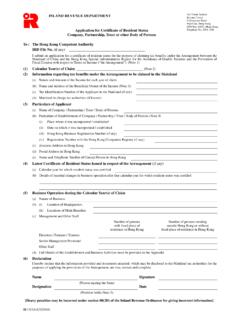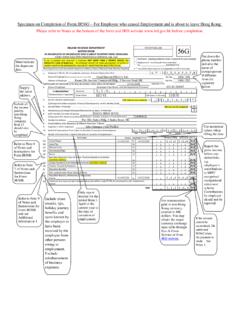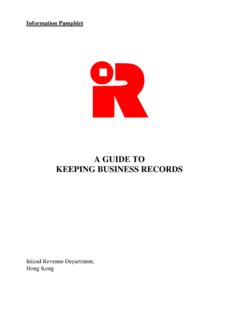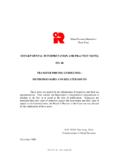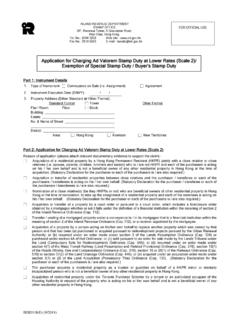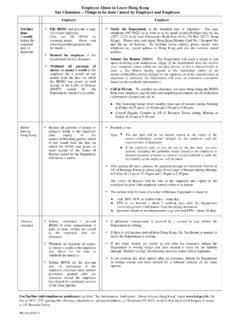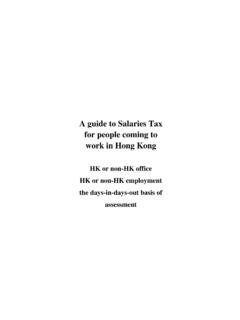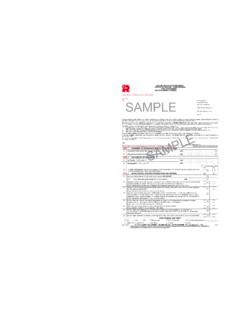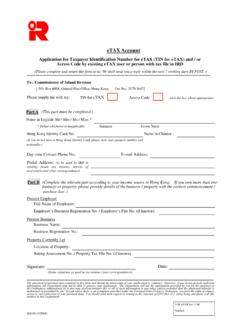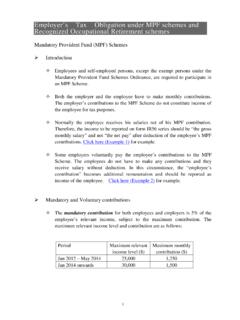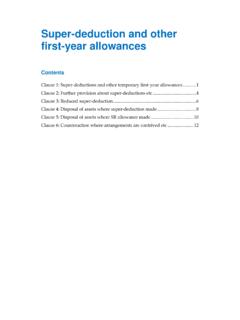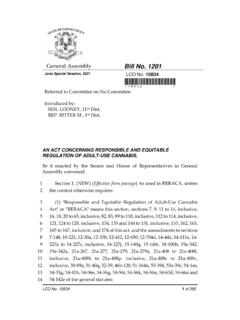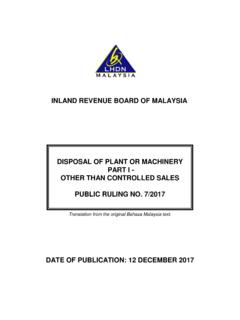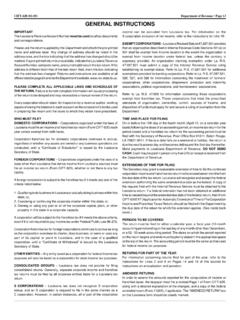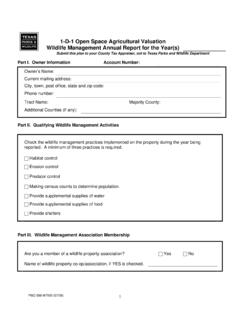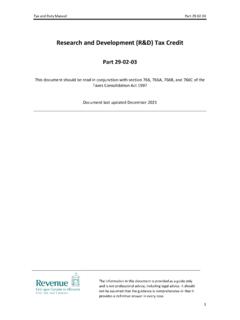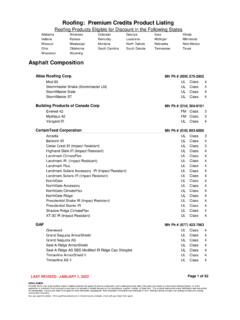Transcription of Departmental Interpretation And Practice Notes - No. 49
1 Our website : Inland Revenue Department The Government of the Hong Kong Special Administrative Regionof the People's Republic of China Departmental Interpretation AND Practice Notes NO. 49 (REVISED) PROFITS TAX DEDUCTION OF CAPITAL EXPENDITURES ON PAT E N T RIGHTS, RIGHTS TO KNOW-HOW AND SPECIFIED INTELLECTUAL PROPERTY RIGHTS These Notes are issued for the information of taxpayers and their tax representatives. They contain the Department s Interpretation and practices in relation to the law as it stood at the date of publication. Taxpayers are reminded that their right of objection against the assessment and their right of appeal to the Commissioner, the Board of Review or the Court are not affected by the application of these Notes .
2 These Notes replace those issued in July 2012. WONG Kuen-fai Commissioner of Inland Revenue August 2020 Departmental Interpretation AND Practice Notes No. 49 (REVISED) CONTENT Paragraph Introduction Relevant legislation 1 Scope of the tax deduction 5 Patent rights, rights to know-how and specified intellectual property rights Patent rights 8 Rights to know-how 9 Specified intellectual property rights - Definition 10 - Copyrights 11 - Performer s economic rights 13 - Protected layout-design (topography) rights 18 - Protected plant variety rights 21 - Registered designs 24 - Registered trade marks 25 qualifying expenditure 26 Timing of deduction One-off deduction in the year of purchase 28 Deduction over 5 years or remaining period of protection 29 Maximum period of protection - Copyrights 31 - Performer s economic rights 33 - Protected layout-design (topography)
3 Rights 34 - Protected plant variety rights 36 - Registered designs 37 - Registered trade marks 38 Capital expenditure incurred prior to commencement of business 39 Conditions for deduction 40 Registration requirement - Registration systems in place 41 - Registration in Hong Kong or overseas 42 - Registration of assignment in process 43 - Invalidation, revocation and surrender 45 Ownership requirement - Legal and economic ownership 46 - Partial ownership 49 Use requirement 51 Production of chargeable profits requirement 53 Summary of deduction criteria - Patent rights and rights to know-how 54 - Specified intellectual property rights 55 Determination of true market value Commissioner s power to determine the true market value 57 Valuation reports 59 Purchased or sold together with other assets for a single price 60 Rights of objection and appeal 61 Apportionment of related capital expenditure Partly used in the production of chargeable profits 62 Basis of apportionment 63 Subsequent disposal Deemed trading receipts from subsequent
4 Sale 64 Relevant proceeds of sale 67 Unallowed amount 69 Deduction not allowed under certain circumstances 70 Purchase with early termination of licence 71 (transitional provision) Purchase from associates 75 Sale and license back arrangement 77 Used wholly or principally outside Hong Kong by other persons 82 Leveraged licensing arrangement 85 ii INTRODUCTION Relevant Legislation The Inland Revenue Ordinance (the Ordinance) has been amended several times since 1983 to allow deduction of capital expenditures incurred on the purchase of different types of intellectual property rights (IPRs) to promote their wider application in Hong Kong. 2. Section 16E, which was enacted in 1983 and amended in 1992 and 2011, relates to the deduction of capital expenditures incurred on the purchase of patent rights and rights to any know-how.
5 3. Sections 16EA, 16EB and 16EC of the Ordinance, which were enacted in 2011, relate to the deduction of capital expenditures incurred on the purchase of copyrights, registered designs and registered trade marks. The scope was expanded in 2018 to cover performer s economic rights, protected layout-design (topography) rights and protected plant variety rights. 4. This Departmental Interpretation and Practice Note (DIPN) sets out the views and practices of the Department regarding the deduction of capital expenditures on patent rights, rights to know-how, copyrights, performer s economic rights, protected layout-design (topography) rights, protected plant variety rights, registered designs and registered trade marks.
6 SCOPE OF THE TAX DEDUCTION 5. IPRs are intangible assets, representing the exclusive rights offered by law to protect a person s creation. While section 17(1)(c) of the Ordinance generally prohibits the deduction of any expenditure of a capital nature, specific provisions in sections 16E and 16EA allow the deduction of capital expenditures incurred on the purchase of: (a) patent rights and rights to any know-how; and (b) copyrights, performer s economic rights, protected layout design (topography) rights, protected plant variety rights, registered designs or registered trade marks (collectively referred to as specified intellectual property rights (SIPRs)). 2 6. Section 16E of the Ordinance provides that, subject to the satisfaction of the prescribed conditions, any capital expenditure incurred by a person on the purchase of patent rights or rights to any know-how, for use in his trade, profession or business in the production of chargeable profits is allowable for deduction.
7 Section 16EA provides a similar deduction for capital expenditure incurred on the purchase of SIPRs. 7. Deduction of the capital expenditure incurred on purchase would be allowed only if it can be substantiated that the right concerned constitutes a patent right, a right to know-how or an SIPR. Thus, in determining whether a right falls within the scope of deduction as defined by the Ordinance, the Assessor would make reference to the relevant statutory registration regime, if one exists, which provides an effective means to ascertain the nature of the right concerned ( a patent right, a protected plant variety right, a registered design or a registered trade mark). If a registration system does not exist for the right in question ( a right to know-how, a copyright, a performer s economic right or a protected layout-design (topography) right), the relevant agreement for sale and purchase will be examined so as to ascertain the precise nature of the subject matter purchased.
8 PATENT RIGHTS, RIGHTS TO KNOW-HOW AND SPECIFIED INTELLECTUAL PROPERTY RIGHTS Patent rights 8. A patent gives its inventor and owner a legal right to prevent others from manufacturing, using, selling or importing the patented invention. A patent is, in effect, a limited property right that a jurisdiction grants to the inventor in exchange for his agreement to share the details of the invention with the public. Registration and protection of patents operate on a territorial basis. A patent being an exclusionary right must be registered with the jurisdiction of such right. The term patent rights is defined in section 16E(4) of the Ordinance to mean the right to do or authorize the doing of anything which would, but for that right, be an infringement of a patent.
9 Thus, in relation to a jurisdiction, any invention not registered with the jurisdiction does not fall within the term patent rights and it is pertinent that deduction will only be allowed for the purchase cost of patent rights in respect of which grants from the relevant authorities have been obtained. 3 Rights to know-how 9. Trade secrets, also described as know-how or show-how , are protected commercially by maintaining secrecy within the business enterprises and by the use of confidentiality agreements. There is no statutory registration for them. The term know-how is defined in section 16E(4) of the Ordinance to mean any industrial information or techniques likely to assist in the manufacture or processing of goods or materials.
10 As a result of this definition, the deduction is confined to trade secrets and confidential information which are related to a manufacturing process. Specified intellectual property rights Definition 10. The term specified intellectual property right is defined in section 16EA(11) of the Ordinance to mean a copyright, performer s economic right, protected layout-design (topography) right, protected plant variety right, registered design or registered trade mark ( SIPRs). Copyrights 11. Copyright is defined to mean: (a) a copyright within the meaning of section 2(1) of the Copyright Ordinance (Cap. 528) (CO), including an unregistered corresponding design as defined by section 87(5)(b) of that Ordinance; or (b) any right that subsists under the law of a place outside Hong Kong in any work in which a copyright referred to in sub-paragraph (a) may subsist and corresponds to a copyright referred to in sub-paragraph (a).
